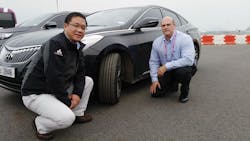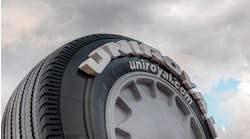Nexen Tire Corp. is increasing its global presence step-by-step. And they aren’t baby steps. The South Korean company continues to increase production capacity, and now has a world-class tire test track at its disposal.
Even when Nexen has to take a step backward, there is plenty of reason for optimism. Travis Kang, president and COO, says the company will rebound in 2015 following a disappointing 2014. “Compared to 2013, 2014 sales dropped a little bit; now we can recover in this year.” Sales totaled $1.7 billion in 2014. This year, they will reach $2 billion, he said.
Nexen’s three-year-old Changnyeong, Korea, plant has increased capacity by 4 million tires over the last year, bringing total yearly capacity to 11 million tires. Annual capacity at its three tire manufacturing plants is 42 million tires (see sidebar).
There is definitely room to grow. In 2018, the highly automated Changnyeong facility will be producing 21 million tires annually, according to Nexen. An increasing number of them will be earmarked for the U.S.
Nexen also plans to increase tire production at its facilities in Yangsan, Korea, and Qingdao, China.
Nexen also is building a plant in the Czech Republic. Kyle Roberts, director of marketing for Nexen Tire America Inc., says the plant will be producing 3 million tires a year in 2017.
“When that is built, it will relieve some of the pressure on the Korean factories, and that will allow for even more capacity to the U.S. market because units that were coming out of the Korean factory for the European market can now be coming out of that Czech Republic plant.”
Kang says unit sales in the U.S. will be close to 5 million tires this year, up from 3.4 million last year. About 50% of the total will be made up of ultra-high performance tires.
If replacement sales reach the 8 million mark, the company would consider building a plant in the U.S. to satisfy demand.
Added value
Nexen Tire America’s pricing has not been affected by the tariffs assigned to consumer tires imported from China.
“Zero U.S. product came out of China last year,” says Roberts. “We had no patterns affected by the tariff.
“We’re anticipating 30 million fewer tires coming into the U.S. market this year from China, and those 30 million tires were at a low price point last year. Nexen plays in that value-priced point range, so those tires fell right into our core business. We have a large opportunity to gain a big part of that 30 million unit share.”
He says Nexen’s quality competes against Tier 2 and Tier 1 tires.
“That’s really our strategy this year: to elevate our brand among the dealers so that they can understand who Nexen really is. Our capabilities are just as good if not better than any of the other tire manufacturers in the world.
“We have to bring that message in a different format back to the states to the dealer network and the retail network so that they understand and say, ‘Wow, Nexen isn’t just a tire that I can charge $80 for. I can get $105, $110 for that tire. I need to start doing that.’ So that is our job: to supply knowledge to the distribution channel so that they can sell the products at their true value.”
Nexen’s Next Level Associate Dealer Program, which launched Jan. 1, 2015, has met its early goal of 2,000 dealers. Roberts says 500 dealers were part of the beta test; to date, 2,200 dealers have signed up.
Close to $1.5 million in bonuses were awarded for first-quarter tire purchases, but that could end up higher because yearly purchase goals are retroactive.
Original equipment
In the U.S., Nexen holds a 1.4% share of the OE tire market. Nexen tires can be found on the new 3500 Ram truck and Chrysler 200 and the Mitsubishi Outlander in addition to vehicles from transplanted Korean manufacturers Hyundai Motor America Inc. and Kia Motors America Inc. Nexen also is OE on the Fiat 500L and 500X, which are produced overseas and exported here.
“Globally, we produce a lot of tires to OE makers such as Chrysler, GM and Ford,” says Kang. “In Europe, we are preparing to produce tires for Mercedes and even Porsche. That is a reflection of Nexen quality.”
It takes at least two years to get a fitment on a model year, according to Roberts.
“To be able to say we are approved for OE fitments says something. We need to get the U.S. consumer and tire retailer to understand that.” ?
The Nexen consumer tire plant in Changnyeong is highly automated, as revealed in this series of photos. 1. 2. Nexen refers to this area as the “Auto-Warehouse.” 3. 4. 5.
More tire capacity!
Nexen Tire Corp.’s three-year-old Changnyeong, South Korea, tire plant makes up only part of a 5.3 million-square-foot complex (see the panoramic view below). When the company’s plant in the Czech Republic is up and running at full capacity, Nexen will be able to manufacture close to 80 million tires a year at its four plants. “Supply is absolutely not a problem,” says Kyle Roberts, director of marketing for Nexen Tire America Inc.
Production efficiency: The result: 42 million tires
Nexen Tire Corp.’s Changnyeong, South Korea, manufacturing plant is the most efficient of the company’s three tire plants. The others are located in Yangsan, Korea, and Qingdao, China. Here is the breakdown of tires produced annually per factory worker per plant:
Plant Annual capacity Tires per worker
Changnyeong 11 million 11,714
Qingdao 13 million 10,196
Yangsan 18 million 9,518
None of the tires produced in China are exported to the U.S.


